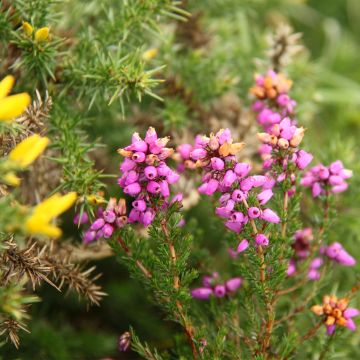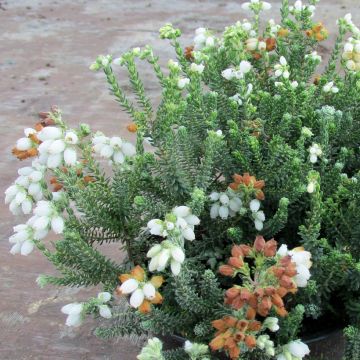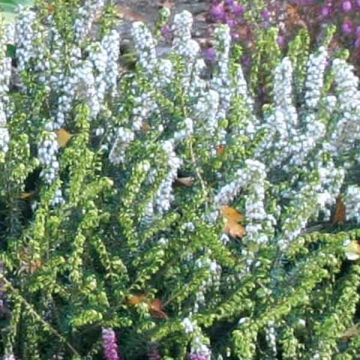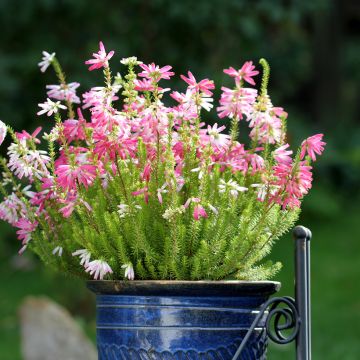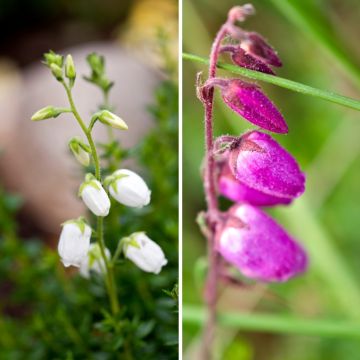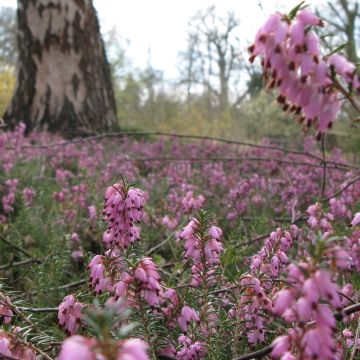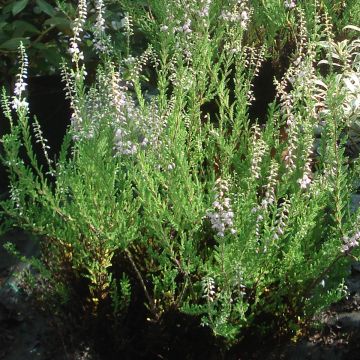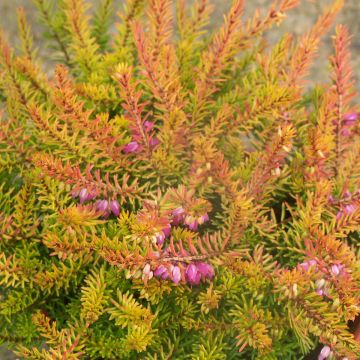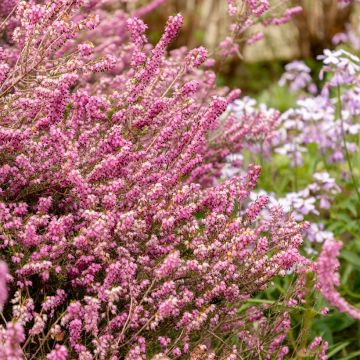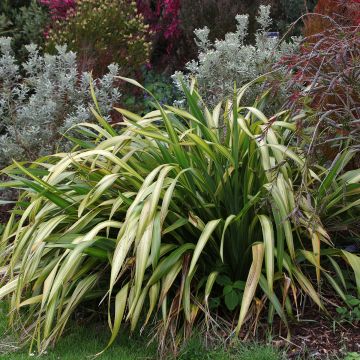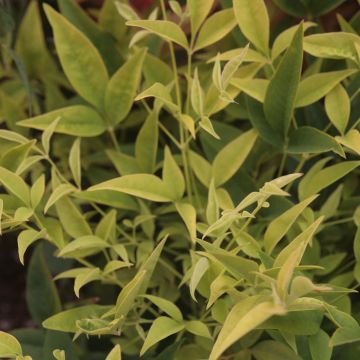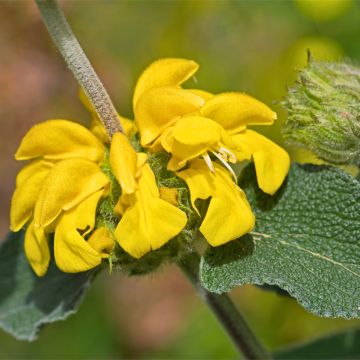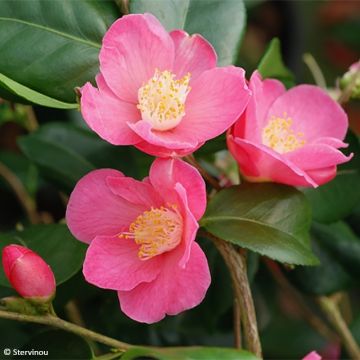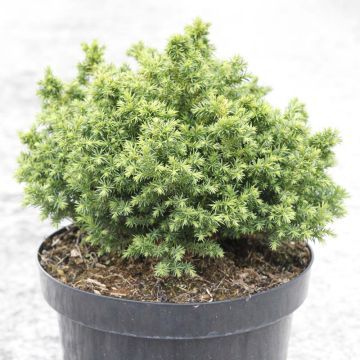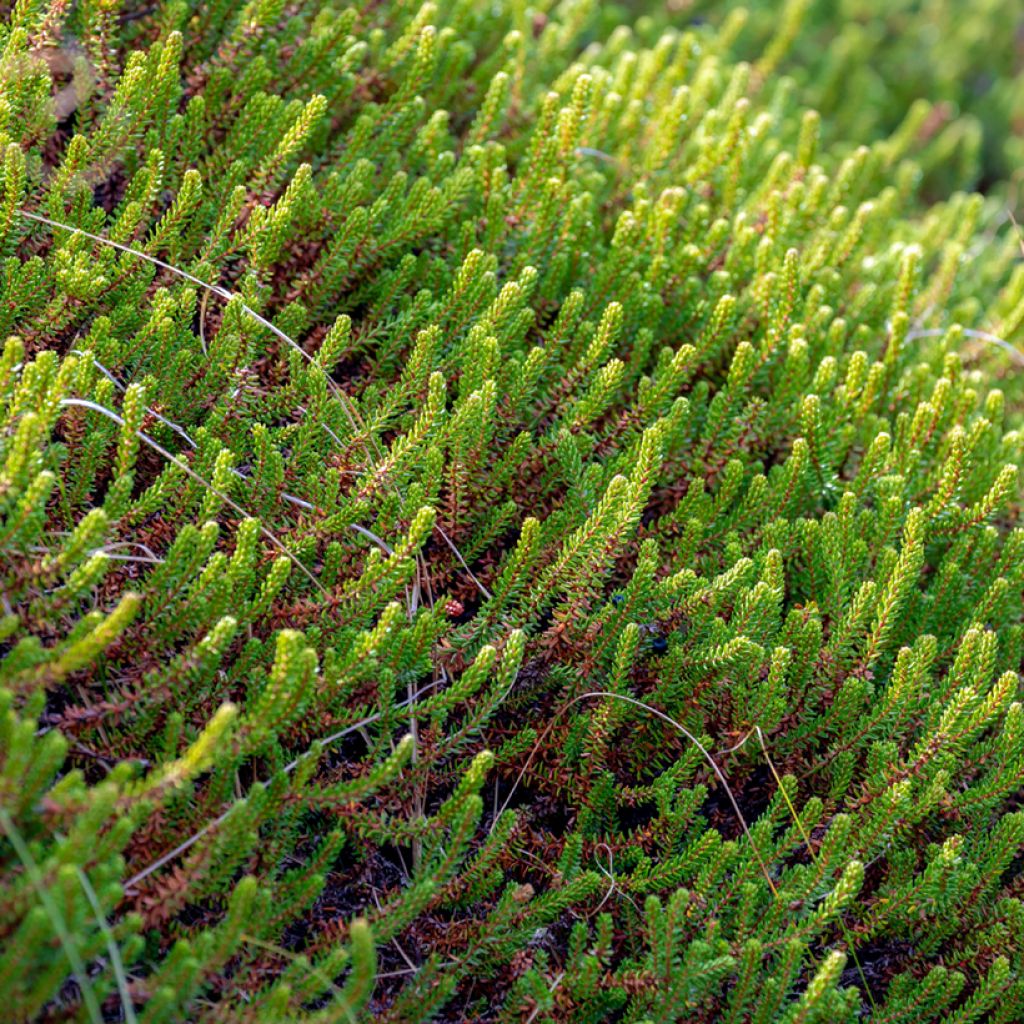

Empetrum nigrum Bernstein
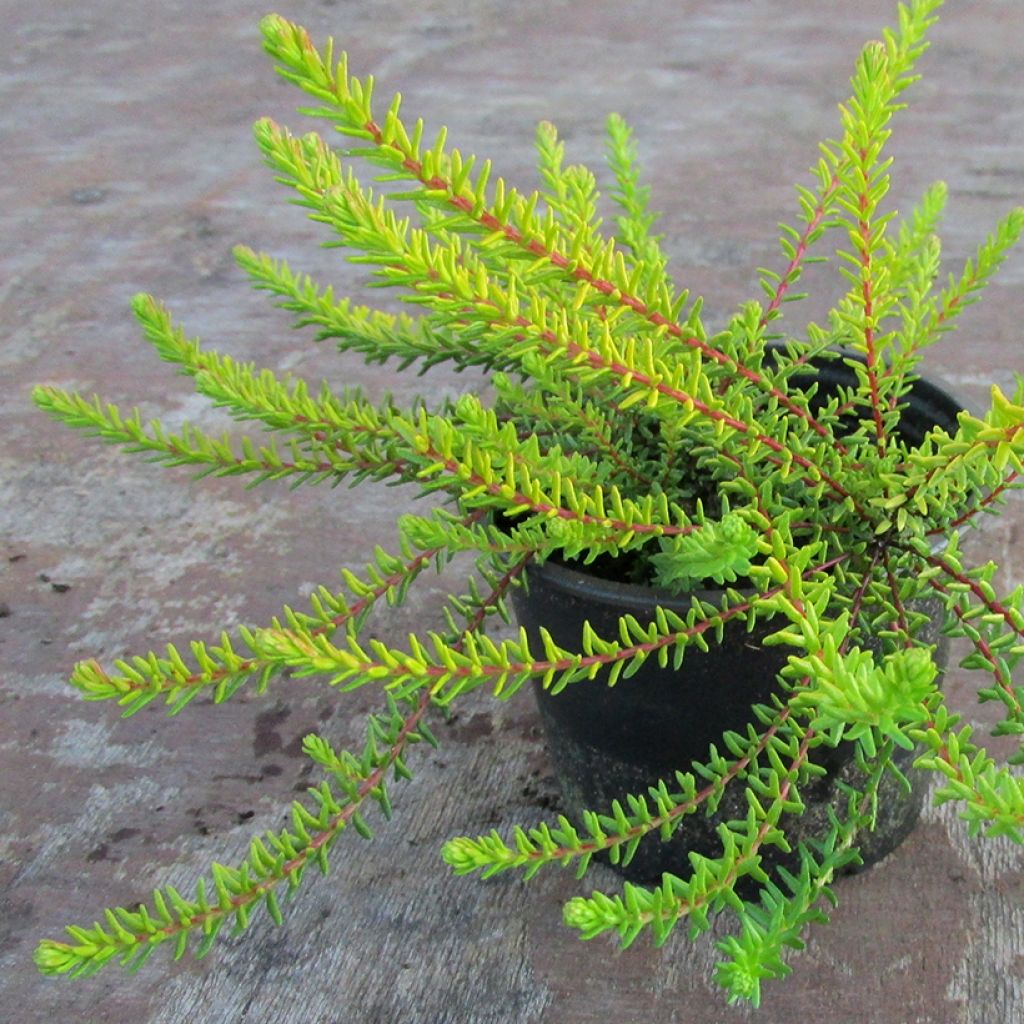

Empetrum nigrum Bernstein
Empetrum nigrum Bernstein
Empetrum nigrum Bernstein
Crowberry
This item cannot be shipped to the selected country
Delivery charge from €5.90
More information
Schedule delivery date,
and select date in basket
This plant carries a 24 months recovery warranty
More information
We guarantee the quality of our plants for a full growing cycle, and will replace at our expense any plant that fails to recover under normal climatic and planting conditions.
From €5.90 for pickup delivery and €6.90 for home delivery
Express home delivery from €8.90.
Does this plant fit my garden?
Set up your Plantfit profile →
Description
The Empetrum nigrum 'Bernstein' is a selection of Black crowberry with remarkable foliage throughout the year, ranging from golden yellow in summer to shades of orange and bronze in autumn and winter. It is an extremely hardy undershrub, ideal for ground cover in ericaceous beds. Its small flowers give way to edible black berries resembling blueberries. It is ideally placed near water features, in borders or cool rockeries, and in acidic and moist soil. To achieve fruiting, it is necessary to plant at least one male plant near this variety.
Empetrum nigrum 'Bernstein' belongs to the Heath family. The species is native to Northern Europe, Central Europe, Siberia, Japan, and northern North America. In the wild, this plant grows in turf bogs and marshes, in lowlands under the coldest climates, seeking refuge in high mountain ranges elsewhere.
It is a slow-growing undershrub with a spreading habit forming a wide ground-covering cushion. As an adult, it will not exceed 20 cm (8in) in height and 50 cm (20in) in diameter. The vegetation of this plant consists of reddish and prostrate stems capable of rooting upon contact with the ground, becoming erect at their tips. The stems are densely covered with small, very narrow and leathery but non-prickly leaves: linear; they are rolled up on themselves and measure 4 to 6 mm (1in) in length and 1 to 2 mm (1in) in width. Their colour changes successively from green to golden yellow, then orange and bronze, from spring to winter. The discreet flowering usually takes place between May and June, depending on the climate. The tiny flowers, 1 to 2 mm (1in) in diameter with 6 tepals, are pink to purplish pink. In this dioecious plant, there are male and female individuals. Only the females will bear fruit, which ripen in September. These lovely berries are fleshy, sweet, and delicious: in Iceland, they are commonly used in delicious jams and to garnish succulent tarts.
Black crowberry 'Bernstein' is one of those shrubs requiring very little maintenance in favorable climate and soil conditions. It forms a variegated ground cover that remains attractive all year round, even in winter. Its small fruits are as tasty as they are rich in vitamins, valuable for helping young and old get through the winter. It is not difficult to find a place for it in the garden, and it is useful for covering the ground in difficult, peaty, or waterlogged areas. For example, several plants can be planted along a pathway, or a few individuals scattered in a rockery. It is an excellent companion for winter heathers, but also for other small undershrubs like gaultherias, or even burnets in not too cold climates.
Report an error about the product description
Plant habit
Flowering
Foliage
Botanical data
Empetrum
nigrum
Bernstein
Ericaceae
Crowberry
Northern Europe
Other Heather
Planting and care
Empetrum nigrum 'Bernstein' prefers full sun to bring out its colours, but it can also tolerate partial shade. It is best suited for planting in mountainous areas with strong contrasts and does not do well in lowlands during the summer. It is recommended to plant the young sapling in either spring or autumn in any acidic to neutral soil, as it cannot handle active limestone (pH range between 4.3 and 7). The plant can survive in poor soils, and even occasional flooding, but it can also withstand some periods of drought in cool climates. Salty soils should be avoided, but the plant's excellent hardiness can tolerate extremely low temperatures of about -45°C (-49°F).
Planting period
Intended location
Care
This item has not been reviewed yet - be the first to leave a review about it.
Evergreen shrubs
Haven't found what you were looking for?
Hardiness is the lowest winter temperature a plant can endure without suffering serious damage or even dying. However, hardiness is affected by location (a sheltered area, such as a patio), protection (winter cover) and soil type (hardiness is improved by well-drained soil).

Photo Sharing Terms & Conditions
In order to encourage gardeners to interact and share their experiences, Promesse de fleurs offers various media enabling content to be uploaded onto its Site - in particular via the ‘Photo sharing’ module.
The User agrees to refrain from:
- Posting any content that is illegal, prejudicial, insulting, racist, inciteful to hatred, revisionist, contrary to public decency, that infringes on privacy or on the privacy rights of third parties, in particular the publicity rights of persons and goods, intellectual property rights, or the right to privacy.
- Submitting content on behalf of a third party;
- Impersonate the identity of a third party and/or publish any personal information about a third party;
In general, the User undertakes to refrain from any unethical behaviour.
All Content (in particular text, comments, files, images, photos, videos, creative works, etc.), which may be subject to property or intellectual property rights, image or other private rights, shall remain the property of the User, subject to the limited rights granted by the terms of the licence granted by Promesse de fleurs as stated below. Users are at liberty to publish or not to publish such Content on the Site, notably via the ‘Photo Sharing’ facility, and accept that this Content shall be made public and freely accessible, notably on the Internet.
Users further acknowledge, undertake to have ,and guarantee that they hold all necessary rights and permissions to publish such material on the Site, in particular with regard to the legislation in force pertaining to any privacy, property, intellectual property, image, or contractual rights, or rights of any other nature. By publishing such Content on the Site, Users acknowledge accepting full liability as publishers of the Content within the meaning of the law, and grant Promesse de fleurs, free of charge, an inclusive, worldwide licence for the said Content for the entire duration of its publication, including all reproduction, representation, up/downloading, displaying, performing, transmission, and storage rights.
Users also grant permission for their name to be linked to the Content and accept that this link may not always be made available.
By engaging in posting material, Users consent to their Content becoming automatically accessible on the Internet, in particular on other sites and/or blogs and/or web pages of the Promesse de fleurs site, including in particular social pages and the Promesse de fleurs catalogue.
Users may secure the removal of entrusted content free of charge by issuing a simple request via our contact form.
The flowering period indicated on our website applies to countries and regions located in USDA zone 8 (France, the United Kingdom, Ireland, the Netherlands, etc.)
It will vary according to where you live:
- In zones 9 to 10 (Italy, Spain, Greece, etc.), flowering will occur about 2 to 4 weeks earlier.
- In zones 6 to 7 (Germany, Poland, Slovenia, and lower mountainous regions), flowering will be delayed by 2 to 3 weeks.
- In zone 5 (Central Europe, Scandinavia), blooming will be delayed by 3 to 5 weeks.
In temperate climates, pruning of spring-flowering shrubs (forsythia, spireas, etc.) should be done just after flowering.
Pruning of summer-flowering shrubs (Indian Lilac, Perovskia, etc.) can be done in winter or spring.
In cold regions as well as with frost-sensitive plants, avoid pruning too early when severe frosts may still occur.
The planting period indicated on our website applies to countries and regions located in USDA zone 8 (France, United Kingdom, Ireland, Netherlands).
It will vary according to where you live:
- In Mediterranean zones (Marseille, Madrid, Milan, etc.), autumn and winter are the best planting periods.
- In continental zones (Strasbourg, Munich, Vienna, etc.), delay planting by 2 to 3 weeks in spring and bring it forward by 2 to 4 weeks in autumn.
- In mountainous regions (the Alps, Pyrenees, Carpathians, etc.), it is best to plant in late spring (May-June) or late summer (August-September).
The harvesting period indicated on our website applies to countries and regions in USDA zone 8 (France, England, Ireland, the Netherlands).
In colder areas (Scandinavia, Poland, Austria...) fruit and vegetable harvests are likely to be delayed by 3-4 weeks.
In warmer areas (Italy, Spain, Greece, etc.), harvesting will probably take place earlier, depending on weather conditions.
The sowing periods indicated on our website apply to countries and regions within USDA Zone 8 (France, UK, Ireland, Netherlands).
In colder areas (Scandinavia, Poland, Austria...), delay any outdoor sowing by 3-4 weeks, or sow under glass.
In warmer climes (Italy, Spain, Greece, etc.), bring outdoor sowing forward by a few weeks.

































